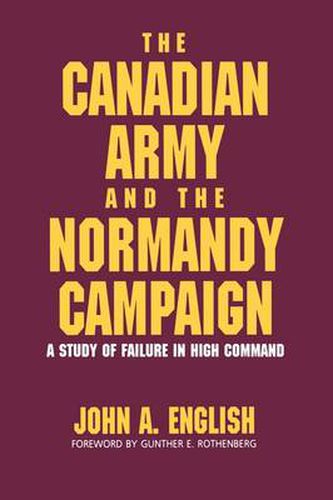Readings Newsletter
Become a Readings Member to make your shopping experience even easier.
Sign in or sign up for free!
You’re not far away from qualifying for FREE standard shipping within Australia
You’ve qualified for FREE standard shipping within Australia
The cart is loading…






The reverses experienced by Canadian troops during the late stages of World War II continue to be the subject of intensive inquiry among military historians. Going beyond the obvious immediate causes of theses setbacks, the author presents a deatiled hsitorical examination of the role of the Canadian army in Normandy and of the organization, training, and fighting-style that the Canadian brought tot he battlefield in 1944. In Part 1, the author analyzes the impact of the British military model on the Canadian corps in terms of doctrine, training, command and staff appointments, equipment, and organization. He discusses the contribution of Canadian troops in World War I and the failure of the Canadian military to maintain a high level of professionalism in the interwar period. Drawing on archival records, particularly Montgomery’s personal correspondence, the author offers new information on attempts to turn pooryl trained troops into an effective fighting force as late as 1943. Part 2 presents a critical analysis on Canadian operations in Normandy. The author gives special attention to the Canadian Army’s inability to close the Falaise Gap in a timely manner–a delay that may have prolonged the war in Europe by several months. Providing both theoretical and practical perspectives on the relationship of peacetime preparation to the operation of large field forces in battle, this work should be of interest to students and buffs of military history and to professional analysts and strategic planners in the armed services.
$9.00 standard shipping within Australia
FREE standard shipping within Australia for orders over $100.00
Express & International shipping calculated at checkout
The reverses experienced by Canadian troops during the late stages of World War II continue to be the subject of intensive inquiry among military historians. Going beyond the obvious immediate causes of theses setbacks, the author presents a deatiled hsitorical examination of the role of the Canadian army in Normandy and of the organization, training, and fighting-style that the Canadian brought tot he battlefield in 1944. In Part 1, the author analyzes the impact of the British military model on the Canadian corps in terms of doctrine, training, command and staff appointments, equipment, and organization. He discusses the contribution of Canadian troops in World War I and the failure of the Canadian military to maintain a high level of professionalism in the interwar period. Drawing on archival records, particularly Montgomery’s personal correspondence, the author offers new information on attempts to turn pooryl trained troops into an effective fighting force as late as 1943. Part 2 presents a critical analysis on Canadian operations in Normandy. The author gives special attention to the Canadian Army’s inability to close the Falaise Gap in a timely manner–a delay that may have prolonged the war in Europe by several months. Providing both theoretical and practical perspectives on the relationship of peacetime preparation to the operation of large field forces in battle, this work should be of interest to students and buffs of military history and to professional analysts and strategic planners in the armed services.